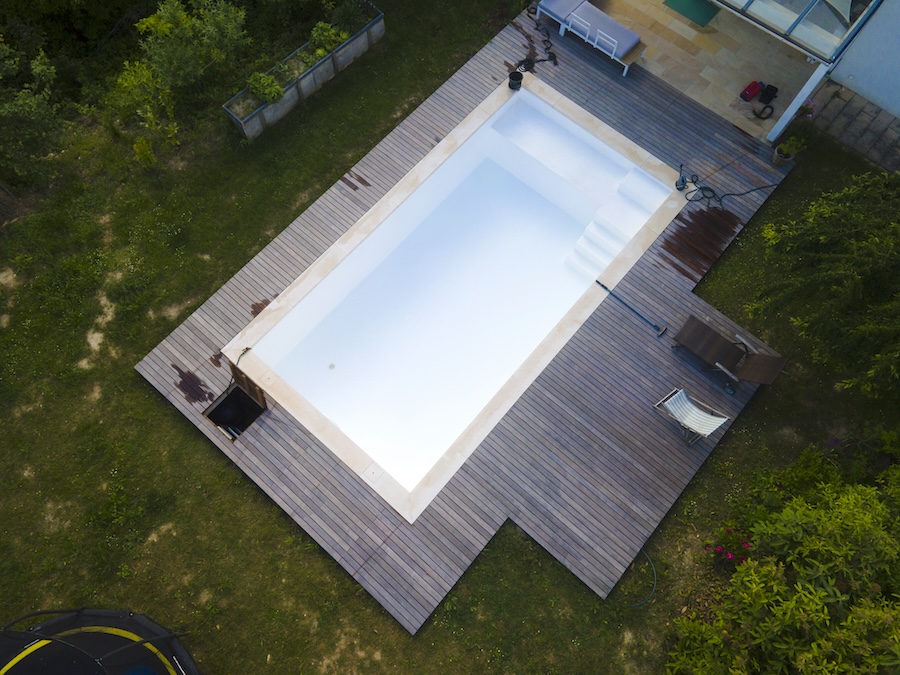Draining a pool is sometimes necessary for maintenance, repairs, or resolving water quality issues, but it’s not as simple as just letting the pool water flow out. Whether you have an in-ground pool or an above-ground pool, following the right draining process is crucial to prevent structural damage and ensure compliance with county health regulations. In this guide, we’ll walk you through the safest and most effective way to drain a pool, including the tools you’ll need, key precautions to take, and steps to follow for a smooth process.
Common Reasons & Optimal Timing for Draining a Pool
- Routine maintenance: Deep cleaning, acid washing, or replacing a pool liner
- Make sure you are following the recommended timing for acid washing, since repeated acid washing can cause pool surface degradation.
- Structural repairs: Fixing cracks, resurfacing, or replacing tiles
- Severe water quality issues: Resolving calcium hardness level buildup or a green pool
- Winterization: Prepping the swimming pool for seasonal closure
- Do not fully drain your pool if you live in a freezing climate, a fully drained pool is not one that is prepared for winter!
When To Drain a Pool
Choosing the right time to drain is just as important as knowing why you are doing so. It’s best to drain during mild weather conditions to avoid excessive heat, which can crack the pool surface, or freezing temperatures, which can slow repairs. Heavy rainfall can also be a problem, as too much groundwater increases the risk of pool pop due to hydrostatic pressure. Planning ahead and following the correct draining process helps protect your in-ground pool and ensures a smooth transition back to a clean, well-maintained swimming pool.
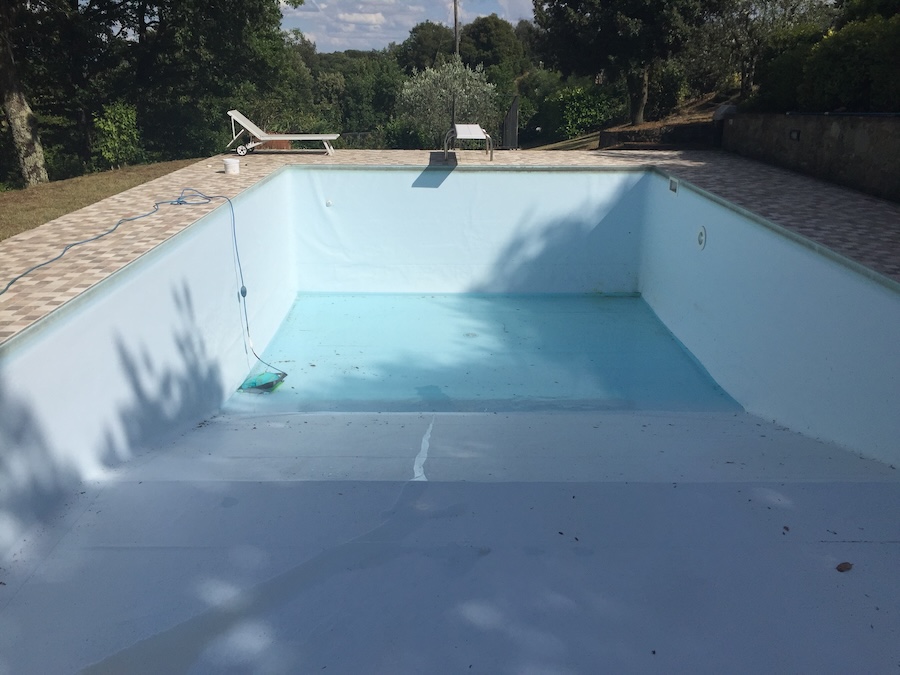
Essential Tools and Safety Precautions
Draining a pool requires the right tools and safety measures to ensure a smooth and damage-free process. Below are the necessary pool equipment and precautions every pool owner should follow before starting the draining process.
Required Equipment
To safely and efficiently drain your swimming pool, gather the following tools:
- Submersible pump or sump pump
- Garden hose
- Extension cord
- Protective gear
Safety Measures
Draining a ground pool or above-ground pool requires careful attention to safety. Follow these precautions:
- Ensure all electrical connections are safe and dry: Never let the extension cord or any other electrical components come into contact with pool water. Keeping them dry prevents electrical hazards.
- Wear appropriate protective equipment: Handling pool equipment and managing a draining process involves risks, so wearing gloves and non-slip footwear can help prevent slips and injuries.
- Monitor the draining process: Always supervise the safe flow rate and water level as you drain the pool to prevent excessive suction at the main or floor drain. Unmonitored draining water can lead to structural damage or flooding in unwanted areas.
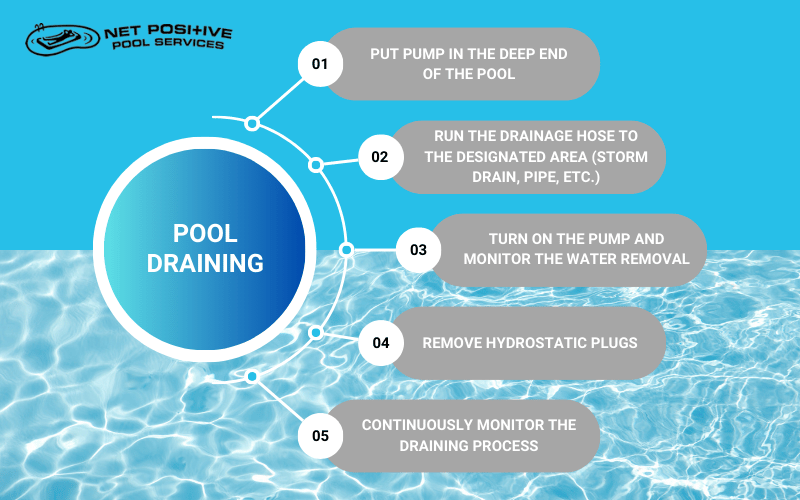
Step-by-Step Guide to Draining an In-Ground Pool
Draining an in-ground pool requires careful preparation and monitoring to prevent structural damage. Follow these steps to ensure a safe and effective draining process.
Preparation
Before starting, take the necessary precautions to ensure you are following local guidelines and to avoid damaging the pool equipment or compromising the pool’s structure:
- Check drainage regulations: Research your local laws on pool water disposal to ensure you are not violating storm drain regulations.
- Turn off all pool equipment: Shut down the pool filter, heaters, and circulation pumps to prevent them from running dry and causing damage.
- Identify the location of hydrostatic relief valves: These valves help release underground water pressure, preventing the pool from lifting out of the ground due to high ground level water.
Draining Process
- Place the submersible pump in the deep end of the pool: Position the submersible pump or sump pump at the deep end to remove water efficiently. For smaller pools, with an easily accessible area that is lower than the pool’s water level, a garden hose siphon can be used instead.
- Run the drainage hose to an appropriate area: Attach a drainage hose or garden hose to direct pool water to a storm drain, clean-out pipe, or designated discharge area that complies with county health regulations.
- Begin pumping water out of the pool: Turn on the submersible pump and monitor the flow rate to ensure a safe flow rate. The poo should drain at a rate of 12 inches per hour, avoid draining too quickly to prevent damage to the main drain and pool drain line.
- Carefully remove hydrostatic plugs: Once the water is almost completely gone, remove hydrostatic plugs one at a time to relieve pressure beneath the pool. Failing to do so can cause the ground pool to lift or crack. Professional consultation on your pool may be necessary to prevent pool damage.
- Continuously monitor the process: Keep an eye on the draining water and ensure the pool equipment and surrounding area remain undamaged. Sudden drops in water level or improper drainage can lead to costly repairs.
Following these steps will help pool owners drain their in-ground pool safely while protecting its structure and longevity.
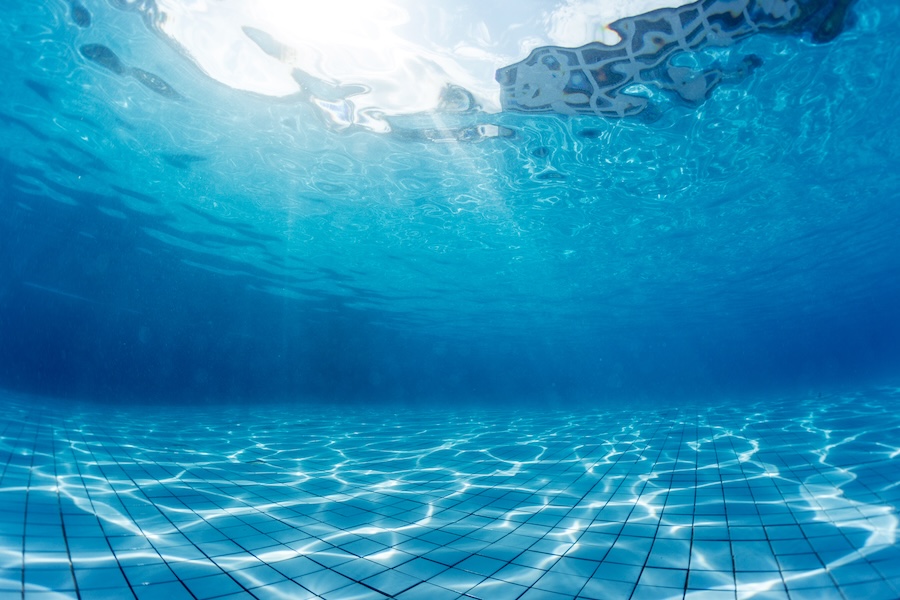
Understanding Hydrostatic Plugs and the Risk of Pool Pop
Draining an in-ground pool is not as simple as just removing the pool water—it requires careful attention to hydrostatic pressure. If done incorrectly, a drained pool can experience severe structural damage, including pool pop, which can lead to expensive repairs.
What Are Hydrostatic Plugs?
Hydrostatic plugs (or hydrostatic relief valves) are small, removable fittings typically located at the deep end of an in-ground pool near the main drain. Their purpose is to relieve underground water pressure that builds up beneath the pool structure.
- Why Hydrostatic Pressure Matters: The ground surrounding an in-ground pool can accumulate groundwater, especially after heavy rainfall or in high water table areas. If the pool water is removed and the external water level is higher than the empty pool, the pressure can push against the pool shell, leading to serious damage.
- How Hydrostatic Plugs Work: When removed, these plugs allow draining water from beneath the pool to flow into the pool shell, equalizing pressure and preventing the pool from lifting or cracking.
What is Pool Pop?
Pool pop occurs when an in-ground pool becomes buoyant due to excess groundwater pressure. Essentially, the pool shell acts like a boat, and without pool water weighing it down, the pressure underneath can cause the entire permanent fixture to lift or “pop” out of the ground.
Factors That Increase the Risk of Pool Pop:
- High groundwater levels: Areas with a high water table or recent heavy rain make pools more susceptible.
- Draining too quickly: Rapidly lowering the water level increases the imbalance between the pool shell and external pressure.
- Failing to remove hydrostatic plugs: Without proper relief, the ground level water pressure has nowhere to escape.
- Draining without professional assessment: If unsure about the groundwater conditions, a pool contractor should be consulted before draining.
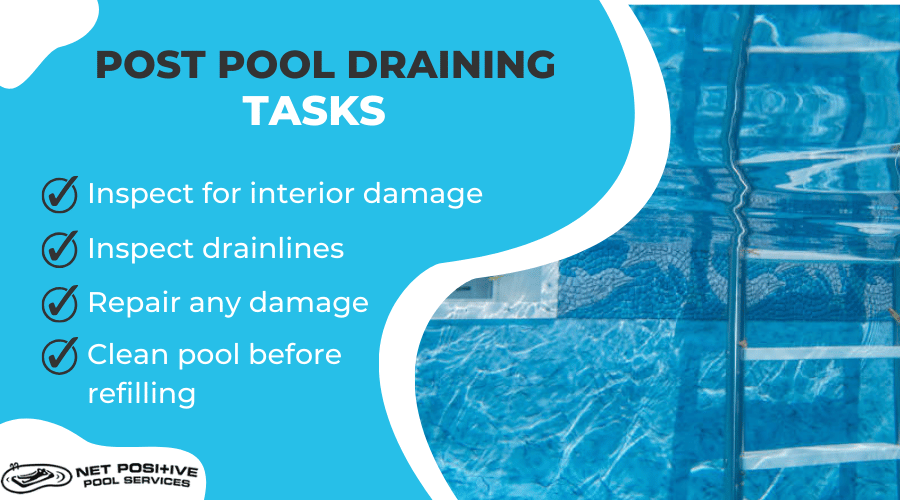
Post-Draining Considerations
Draining an in-ground pool or above-ground pool is just one part of the process. After removing the pool water, pool owners should take the time to inspect, clean, and prepare the pool before refilling. Proper post-draining maintenance helps prevent long-term damage and ensures a smooth transition back to a clean, well-functioning swimming pool.
After Draining: What Comes Next?
- Inspect the pool’s interior for damage or wear
- Carefully examine the pool surface for cracks, stains, or peeling paint that may have been hidden by the water.
- Check for calcium hardness level buildup, which can appear as white, chalky deposits on the pool walls.
- Look at the pool equipment, including the pool drain, cartridge filter, and main drain, to ensure they’re in good condition.
Necessary Maintenance or Repairs
- If you notice damage, now is the time to repair pool liners, safety covers, or cracks in the plaster.
- Clean or replace the cartridge filter to ensure the filtration system works efficiently when the pool is refilled.
- Inspect and clean the pool drain line and floor drain to prevent clogs that could impact water circulation.
- Scrub the pool walls and floor to remove algae, debris, and mineral deposits. For tough stains, an acid wash may be necessary.
- Double-check that the main drain, drain line, and filtration system are functioning properly.
Taking these steps before refilling your pool will help maintain water quality, extend the life of your pool equipment, and prevent costly repairs down the road.
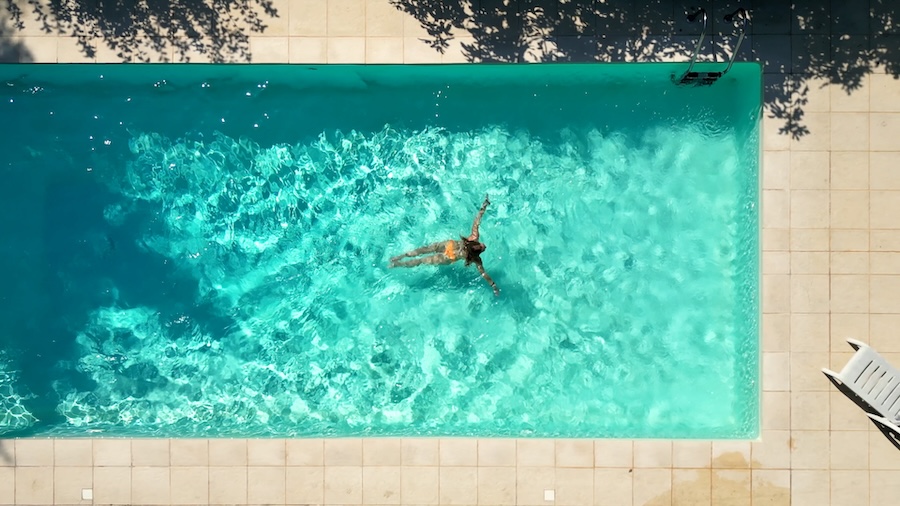
Services Offered by Net Positive Pools
At Net Positive Pools, we understand that proper swimming pool maintenance is essential for longevity, safety, and a hassle-free experience. Whether you’re dealing with routine upkeep, unexpected repairs, or preparing for seasonal changes, our team of experts is here to help. We provide a variety of expert services including:
- Professional maintenance services
- Leak detection services
- Pool equipment repairs and replacements
- Pool start up or closing services
- Filter cleaning
- Liner solutions
- Acid wash
Whether you need routine service, emergency repairs, or expert advice on maintaining your pool, Net Positive Pools is your trusted partner. Contact us now and let us handle the hard work so you can get back to enjoying your pool.
